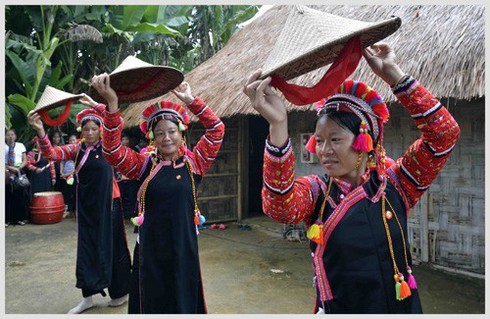The northern mountain region is home to many groups including the Muong, Tay, Thai, Dao, and La Hu. The La Hu, one of the smallest groups in Vietnam, with a population of about 10,000 people, live mainly in Muong Te district, Lai Chau province.

They celebrate the new lunar year in the last 2 weeks of the 12th month. Each family chooses a day compatible with the birthdate of the head of the family to celebrate Tet.
Phan Phu Lo in Tan Bien hamlet said, “The La Hu celebrate the traditional New Year festival for a whole month. Hamlets celebrate Tet in different weeks, so they have time to visit their neighbor’ celebration. Guests and hosts always exchange New Year’s gifts to deepen their relationship.”
The La Hu make cylindrical sticky rice cakes. Children carry the cakes with them during Tet as a symbol of sufficiency and prosperity.
The Giay in Lao Cai celebrate many festivals throughout the year. The lunar new year is the biggest festival. During Tet, they make many kinds of cakes from sticky rice and pork.
Luc Thi Nhinh of Ta Phoi 1 hamlet said their traditional sticky rice cake is called humpback cake. “We must make humpback cakes for Tet and a celebration in late January to end the Tet holiday. We bind three humpback cakes together to offer to our ancestors.”
Ethnic groups in the central region welcome Tet with unique customs. The Gie Trieng in Quang Nam and Kon Tum province call it the charcoal Tet. Three days before Tet, young men burn trees to make charcoal.
Some people cook sticky rice paste on dry wood, and burn it to charcoal. The two types of charcoal are mixed and thrown on people. The more charcoal that sticks to their body, the luckier they will be.
The Hre in Quang Ngai province also celebrate Tet for a whole month. They prepare many cakes, pork, beef, and wine for worshiping and for parties.
The New Year celebration, Chol Chnam Thmay, of the Khmer takes place for 3 days starting on April 13th or 14th. People gather at pagodas to pray for a great new year.
Monk Kim Tue of Kho Me pagoda in Soc Trang province said, “During Tet people come to the pagoda to make sand dunes, which represent sacred Buddhist towers. People want to accumulate good fortune for their children.”
Backward customs have been eliminated. Ethnic people have adopted cultural community activities compatible with their traditions.
Tran Huu Son, Vice Chairman of the Vietnam Folklore Arts, said, “Ethnic groups now observe the New Year celebration with modified traditional features. In the past, for example, they avoided welcoming guests on the first day of the New Year, particularly women. Now they will receive guests in the afternoon.”
VOV
 The Vietnamese nation has 54 ethnic groups. Each group has its own culture, customs, language, lifestyle, costumes, and celebrations. The ways they celebrate Tet, the lunar New Year, add color to the Vietnamese culture.
The Vietnamese nation has 54 ethnic groups. Each group has its own culture, customs, language, lifestyle, costumes, and celebrations. The ways they celebrate Tet, the lunar New Year, add color to the Vietnamese culture.